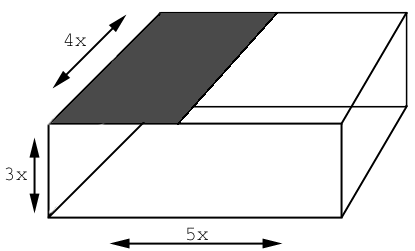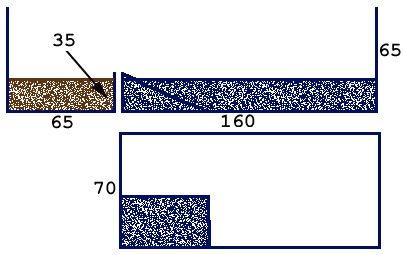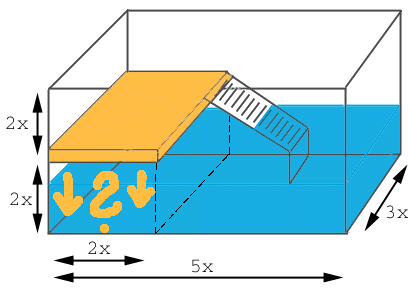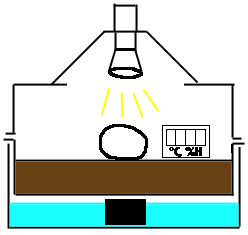Last major update of this page was in summer 1997. I am quite not satisfied
with the content. I am working on a new version which I plan to finish till the end of the first
quarter of 1999. I am sorry to use the “time shortage” argument -- unfortunately, it's true.
Please accept my apology.
dk
Turtles and tortoises in wild have virtually unlimited space. Their teritories are from couple square meters to few square kilometers -- differ by species. Their setup must be a matter of compromise between natural demands and a keeper's possibilities. In aquatics is good to think about the water amount more than about a tank size only. More water means the better stability and self-cleaning. Some of possible mistakes may have chance to be less dramatic or tragic comparing to the situation in smaller tanks.
One of the examples of the minimal size of suitable tank is in the picture - substitute the x with the length of tortoises multiplied with their amount. For each specimen, it is best to use the type of soil common to their origin. Recommended is the thick layer of it for digging, varied terrain, a natural hiding place, a place heated with 25W bulb for basking and/or the heating pad. For the cold-sensitive specimens the top of the tank must be partly covered with glass or something similar to prevent draught.


This is the picture of my sliders' tank. A wild forest is above.

It is necessary to regularly remove excrement and - from time to time - change all the soil (or sand) and carefuly wash their territory. Many diseases come from parasites (mites) due to unclean dirt. The turtles who live in water need much more care. I recommend underwater filtration system suitable for turtles. For the efective filtration is recommended (f.i. by Highfield) the undergravel filter. Even so it is necessary to change water and wash the sand and rocks even at least once each week.

Watch the turtles' condition all the time, if you trust your vet, take your turtles there once a year. Some of these guys are kinda familiar with turtles.
Unfortunately my experiencies in
this are very sad. I took two tortoises to the veterinary assistant at
Chodov four years ago. One had an elongated beak which hindered eating,
one with dislocated leg. That veterinary doctor was evidently a shit who
did not recognise animals smaller than cow. Besides that he loathed the
tortoises and refused to touch them with his hand. He required me to pull
the tortoises head out to be able to look at the leg. My second tortoise,
Barbora, with the beak took such a wrench
and the vet was trying to cut it off such incompetently that I realised
he wanted her head as a trophy to his collection. I forbade him to do that
and did it myself at home.
Unfortunately I could not cure the first tortoise
so simply. Instead of taking a look at the X-ray pictures of tortoise which
I had (I worked in the oncology hospital), “doctor” started to prattle
something about vitamines (probably a bribe from the manufacturer). He
wrote an alibistic prescription (did neither harm not good as I learned later), asked for cash
and threw us out. RIP to Martin - he died less than week after:
Was swollen so that his shell did not hold him and he suffocated (which is terrible for the
tortoise in spite of the metabolism). There was no other way in these days.
The most urgent diseases are respiratory (turtle “coughs”, has full nostrils etc.). Especially the water turtles easy become sick by draught in relatively warm water and cold air. Their eyes become inflammed which can cause blindness or can become a serious lung disease.
Others diseases used to be caused by moulds, funghi and parasites. The turtle hardly moves, refuses to eat and its eyes loose their typical gloss.
Vitamines deficiency causes a peeling of the shell parts in beginning, in long terms even the wrong shape of bones and shell. A chronic state will end with the permanent deformations. For this reason the keeper has to insist on a wide variety in food. You have to keep offering it even if your turtles prefer other food all the time.
Healing is mostly based on increasing the temperature. Start with antibiotics and vitamines as recommended your vet (too many vitamines can cause more serious problems than the other extreme). If the turtles don't have enough vitamine D (D3) and is impossible to let them bask in sunlight, it is recommended to use, once a week, a quartz (UV) lamp for a few minutes, always from above to avoid the problems with eyes.
Naturally turtles love best of all - both aquatic and land ones - a sunny summer day outside in a quiet hidden place where there is sufficient quantity of their natural food. If you are able to build a pen for them, they'll become very happy. It should contain a shelter, a sun-bathing place, a water source, of course a pond for the water turtles, a suitable place for egg laying by their natural habits. It must be fenced well to prevent them from escaping and should be better enclosed like an aviary to protect them from beasts. Hints for each type of turtle can be found in the links here (from the gallery). If your turtle (or your planned turtle) is not listed there, write me an e-mail, I can put it right.
I write the data about this on the pages of the respective turtles. Though it is possible to hatch some turtles outdoors, for better success it is necessary to use an incubator. In picture is the simpliest - above the bottom layer of water is a vessel with perforated bottom filled with a vermiculite gravel or similar substrate. a sand itself is not suitable mostly. The eggs should be put on this. These two vessels are covered with the third. The access of the fresh air (no draught!) must be enabled - the embryos must breathe inside the eggs otherwise they die from anoxia. Heating can be in water, with thermostate, or from above with a bulb (which is much cheaper but less suitable). Inside should be an accurate thermometer (and humidity meter) as near as to the eggs is possible - to keep a “warm damp summer” (30.5 Celsius grades, 50-70% humidity for arid environment species of tortoises, for tropical species and aguatic turtles up to 100%).
